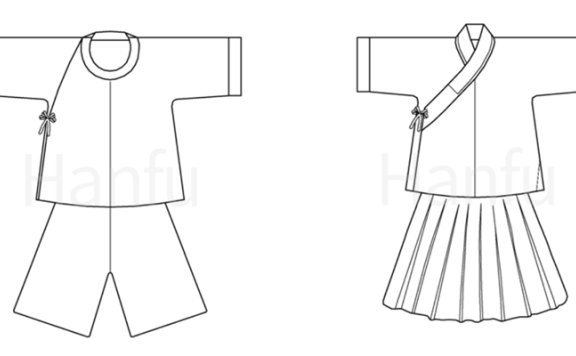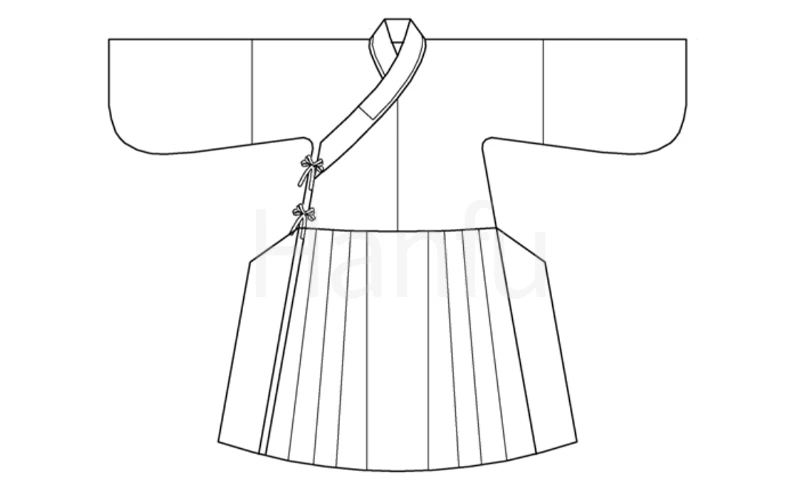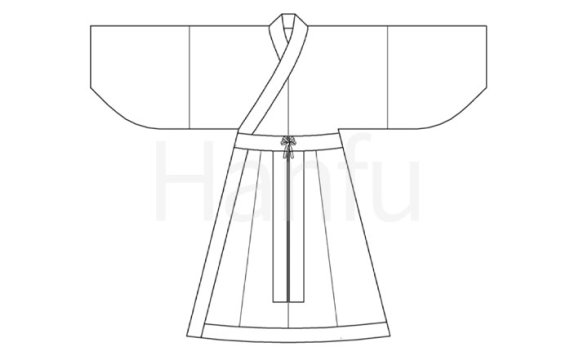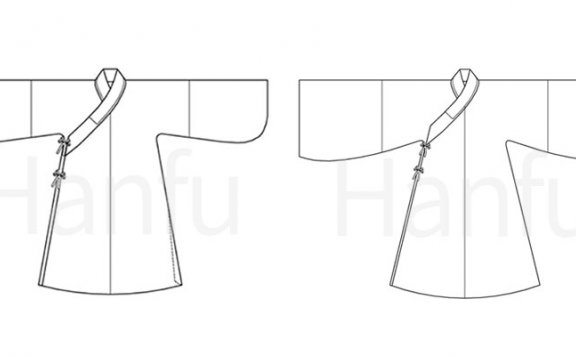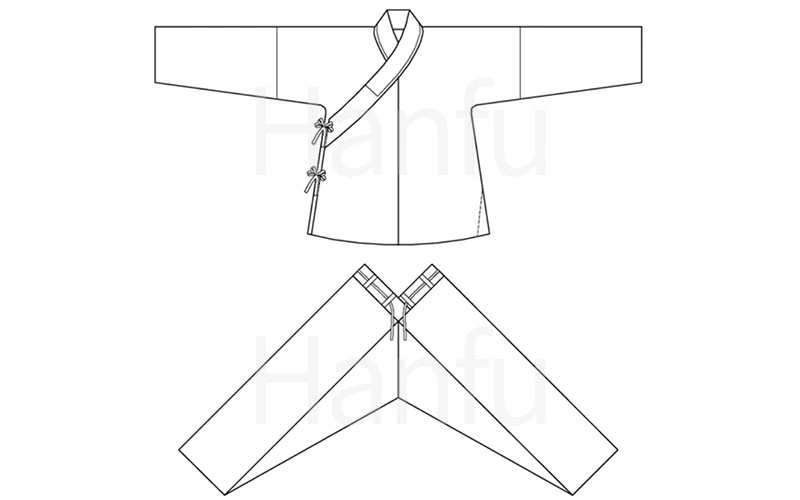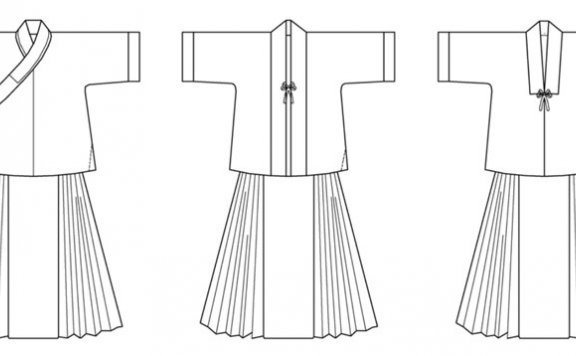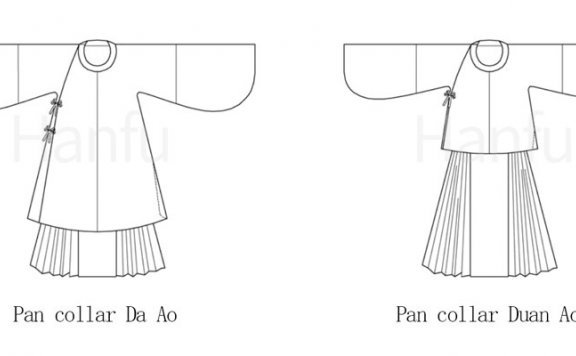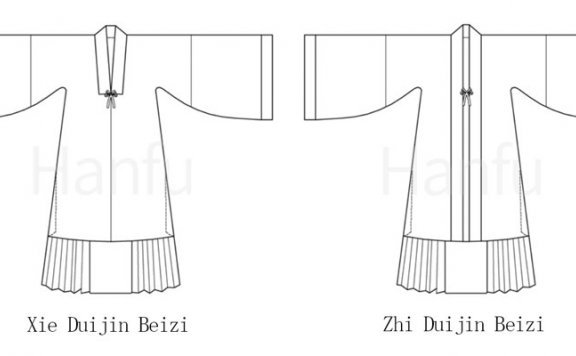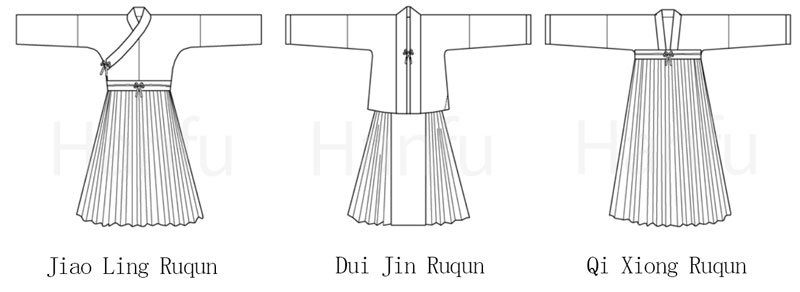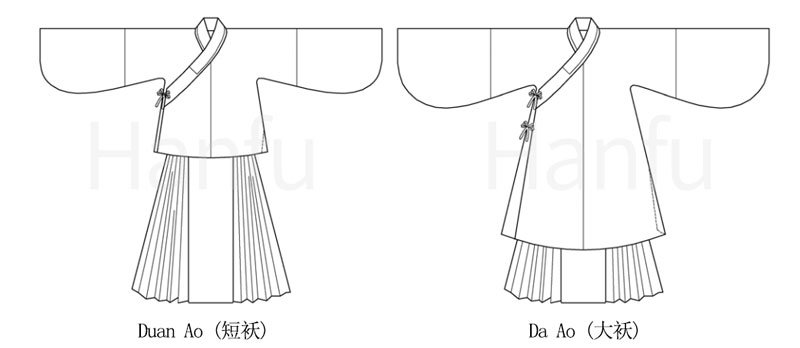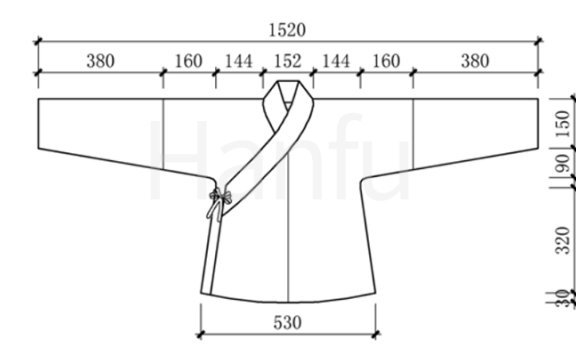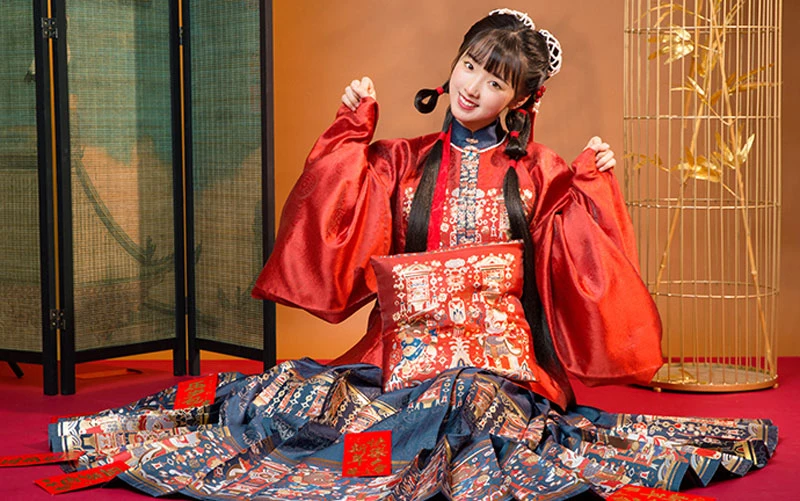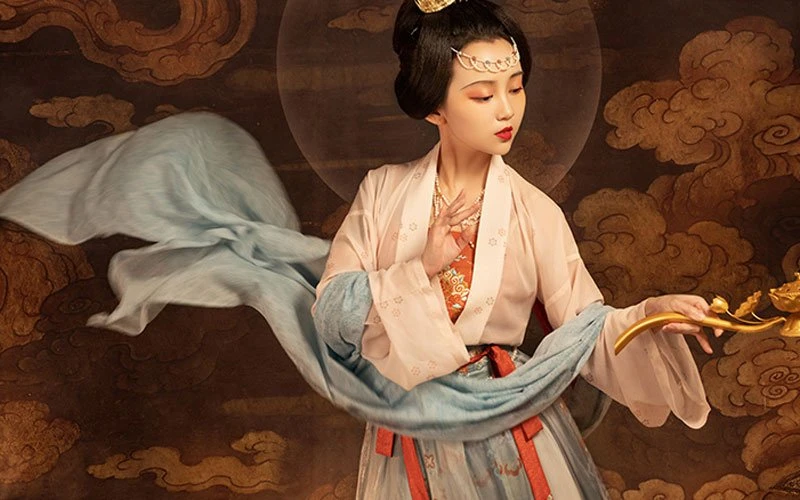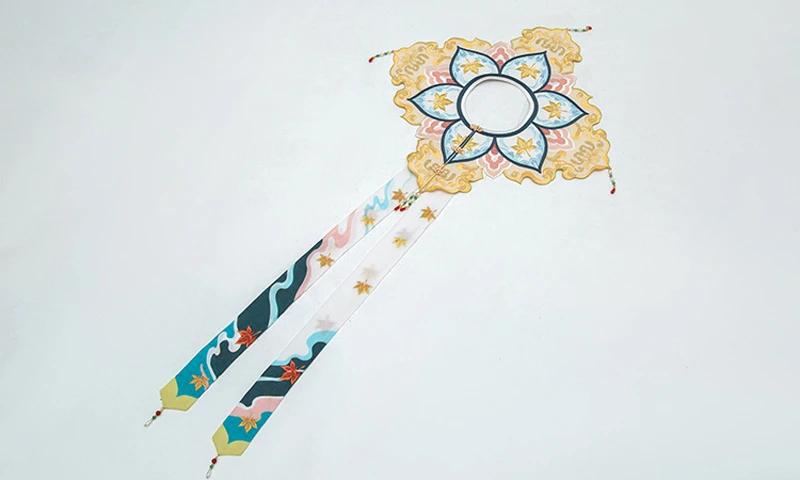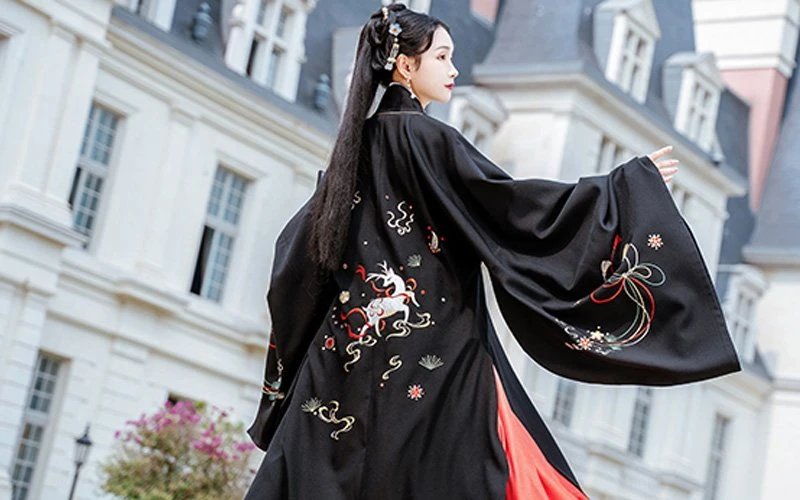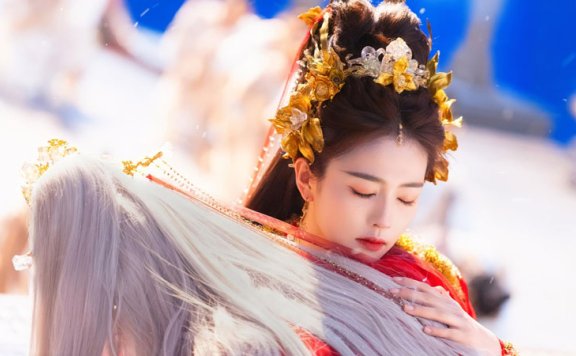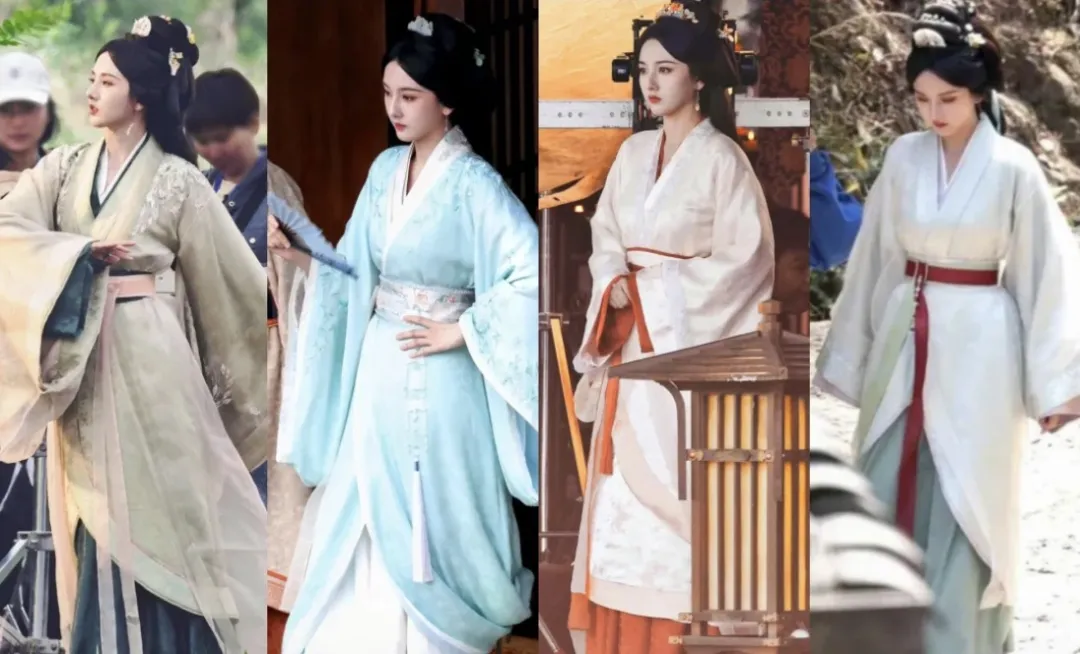Article
搜索结果:
-
Hanfu Making(13) - Improved Hanfu Cutting & Sewing Patterns
This section contains improved Hanfu (改良汉服). Please read the introduction of the topic and how to use this guide in advance. Introduction Wearing hanfu is not just for the sake of retro and vintage, but also to show classical beauty and promote the traditional culture of the nation. However, many people have misconceptions about hanfu, believing that the process of wearing hanfu is tedious and that it is not convenient to move around after wearing it. In fact, hanfu is not necessarily a wide robe with big sleeves. The hanfu system itself contains short and slim tops, as well as short-sleeved and narrow-sleeved types of clothing. The hanfu tops can be matched with modern skirts and pants with a little improvement of the form, as long as the shape and color match. The "improvement" referred to here is not to develop to Western-style three-dimensional cutting, but to make certain modifications to the hanfu pattern, such as reducing the sleeve length and cuff width, and making slight modifications to the shape to make it more suitable for matching with modern clothing, combining tradition with fashion, while maintaining the basic shape and flat cutting method of hanfu. It is hoped that this improved… -
Hanfu Making(12) - Yisan Cutting & Sewing Patterns
This section contains Yisan (曳撒, yì sǎn). Size range: 165/88A to 185/104A. Please read the introduction of the topic and how to use this guide in advance. Introduction Yisan is one of the costumes of the Ming Dynasty, evolving from the Yuan Dynasty Bian Xian Ao (辫线袄), but it is still part of the hanfu system because it has a cross collar and has long been incorporated with Han Chinese elements. The shape of Yisan is very special. The front part is cut and sewn separately, the upper garment is short from the front, and the lower garment with pleats is connected at the waist. The back part is cut as a whole, the length is equal to the front garment length plus the lower garment length, and there are no pleats like other long garments. There is hem on both sides of Yisan, also called "Er (耳)" Yisan was mostly worn by military officials or members of the imperial family in the Ming Dynasty, and could be used as riding clothes, and one of the main uniforms of the Jingyiwei officers was Yisan. The fabric color of Yisan was usually red, blue, dark green, etc., and could be embroidered… -
Hanfu Making(11) - Shenyi Cutting & Sewing Patterns
This section contains Shenyi (深衣). Size range: 165/88A to 185/104A. Please read the introduction of the topic and how to use this guide in advance. Introduction Shenyi is a long, straight Changshan with a separate upper Yi (衣) and lower Chang (裳), and joined together to cover the body. There are many different ways to cutting and sewing a Shenyi, but this section is only one of the simpler ones. To make a Shenyi, 12 pieces of equal-sized trapezoidal fabric are prepared and sewn together as a lower Chang, then the upper Yi garment and lower Chang are sewn together. It is also necessary to use another color of fabric as the edge, which eventually the completed Shenyi. The fabric of Shenyi is mostly white cloth, and the edge needs to be made of darker color fabric. In ancient times, if both parents and grandparents are alive, the edge is made of patterned fabric; if the parents are alive, the edge are made of cyan fabric; if orphans, edges are made of plain fabric. Shenyi gives people a graceful and elegant feeling. The basic features are cross collar, wide sleeve roots, slightly closed cuffs, and a Dadai (大带) as a… -
Hanfu Making(10) - Panling Pao and Lanshan Cutting & Sewing Patterns
This section contains Panling Robe (盘领袍), Lanshan (襕衫). Size range: 165/88A to 185/104A. Please read the introduction of the topic and how to use this guide in advance. Introduction In the Sui and Tang dynasties, the basic features of the Yuanling Shan (圆领衫, round neck shirt) were narrow sleeves, a slightly shorter length, and a straight strip of cloth standing on top of the collar. Later, the collar of the round neck shirt began to gradually become wider and lower, to the Song dynasty, has completely become the collar edge of the pan collar spreading, while the cuffs become larger, the body of the garment becomes longer. Ming-style Panling Pao (pan collar robe) added hem on the basis of Song style, its collar production process is generally straight cloth strip folded, and then ironed into shape, along the inner circle with line sewing tight, so that the collar edge curved to fit the round neckline, collar edge end nailed with buttons for fixed. The Panling Robe was widely used as imperial costumes and official uniforms in the Ming Dynasty, with the basic features of a pan collar, Pipa sleeves or wide sleeves, and hem on both sides of the garment.… -
Hanfu Making(9) - Zhiduo Zhishen Daopao Cutting & Sewing Patterns
This section contains Zhiduo (直裰), Zhishen (直身), Daopao (道袍). Size range: 165/88A to 185/104A. Please read the introduction of the topic and how to use this guide in advance. Introduction Zhiduo is a kind of costume from the Song Dynasty, the initial is mostly worn by monks, a few literati also wear, Song Zhiduo is generally not slit. By the Ming Dynasty, Zhiduo had become widely popular among literati and scholars, and the basic features of Ming Zhiduo were the cross collar, knee-length garment, slit on both sides without Bai (摆), generally with a collar guard on the collar, and mostly with pipa sleeves. The cutting and sewing patterns in this chapter are based on Ming Zhiduo. Zhishen was also an important costume of the Ming Dynasty, as well as Zhiduo and Daopao, the basic features of Zhishen are the same as Zhiduo, with a cross collar, more collar protection, pipa sleeves, and knee-length, but the difference is that there is outside Bai on both sides in Zhishen. Daopao is one of the traditional costumes of Taoism, but it was also the main style of casual wear and dress for scholars in the Ming Dynasty, so Daopao was not… -
Hanfu Making(8) - Shuhe Cutting & Sewing Patterns
This section contains Shuhe (裋褐). Size range: 165/88A to 185/104A). Please read the introduction of the topic and how to use this guide in advance. Introduction Shuhe (裋褐), also known as "Duan Da (短打)", originally meant a coarse cloth upper garment woven with coarse hemp or animal hair, was a simple cross-collar upper garment worn by commoners in ancient China, usually with looser pants underneath, mostly used for casual wear or work clothes. The basic features of the Shuhe are Jiao Ling You Ren (交领右衽, cross collar and wrapping the right side before the left), the shortest sleeve length over the wrist, the longest slightly beyond the fingertips, mostly straight sleeves or arrow sleeves, narrower cuffs, the length of the garment to below the waist, the longest above the knee, and the two sides need to be divided into slits. Shuhe can not simply be equated with the cloth worn by the poor, although this garment can not do the formal occasions worn by the dress, but its use is very wide, and the use of Shuhe is determined by its characteristics, because wearing Shuhe more convenient for action, so it has become a daily work, farming, long-distance travel necessary… -
Hanfu Making(7) - Banbi Cutting & Sewing Patterns
This section contains Banbi (半臂). Size range: Jiao Ling Banbi (155/80A to 185/104A), Zhi Dui Jin Banbi and Xie Dui Jin Banbi (155/64A to 175/96A). Please read the introduction of the topic and how to use this guide in advance. Introduction Banbi (半臂), also known as "half-sleeve", is a short tunic developed from the upper Ru (襦) since the Wei and Jin Dynasties, and can be roughly divided into two collar types: Jiao Ling (交领, cross-collar) and Dui Jin (对襟, lapel). Compared with long-sleeved tops, the difference is that the sleeve length can reach the elbow. In the Tang Dynasty, the Banbi was already a popular garment worn by both men and women. In the long years, its wearing method is also basically limited to the set of other long-sleeved clothes, because in formal occasions, the ancient people will never wear Banbi alone and show the arm. But with modern aesthetics, today's Jiao Ling Banbi (交领半臂) can be worn alone in summer, which is somewhat similar to the short-sleeved T-shirts worn by modern people, and because of its shorter sleeve length, it does not hurt to pair it with a modern skirt, and men can also wear a Banbi with… -
Hanfu Making(6) - Quju Cutting & Sewing Patterns
This section contains Quju (曲裾). Size range: 155/80A to 175/96A. Please read the introduction of the topic and how to use this guide in advance. Introduction The basic style of the Quju is the Jiao Ling You Ren, the back lapel is lengthened to form a triangle, which passes down the back and around to the front lapel, and then a Dadai (大带) is tied around the waist to cover the end of the triangle, with a pleated skirt underneath. The Quju was popular from the pre-Qin to Han dynasties, before the invention of the Ku (袴), and could be worn by both men and women, with the hemline of the men's Quju being wider and the hemline of some women's Quju taking on a unique "trumpet flower" style. Later, men's Quju gradually disappeared, and for a long time, Quju remained in the mainstream of women's clothing. However, in the Wei and Jin Dynasties, the Ruqun, which was easier to wear and more convenient for walking, became widely popular, while the Quju began to disappear, and in the long history that followed, the most popular women's clothing was the Ruqun style. Although the Quju disappeared early in history, it… -
Hanfu Making(5) - Pan Collar Aoqun Cutting & Sewing Patterns
This section contains Pan collar Aoqun (盘领袄裙), which can be divided into: Pan collar Da Ao (盘扣大袄), Pan collar Duan Ao (盘扣短袄). Size range: 155/80A to 175/96A. Please read the introduction of the topic and how to use this guide in advance. Introduction The round collar tunic was not originally a Han dress, but a new type of dress introduced in northern China during the Sixteen Kingdoms period (when the southern part was under the Eastern Jin Dynasty), and became completely popular in ancient China after the Sui and Tang dynasties. However, this costume has evolved over time and has become completely Han Chinese, and as such has become an important and indispensable style in the Han clothing system. The Ming system Pan collar is a kind of round collar, evolved from the Sui and Tang round collar, generally straight cloth is first folded in half, then ironed into shape, along the inner circle with thread sewn tightly, so that the collar edge curved into a round shape, and the end of the collar edge nailed with buttons for fixed. The Pan collar Da Ao (盘扣大袄) can be used as a woman's formal dress, usually with Pipa sleeves or wide… -
Hanfu Making(4) - Beizi Cutting & Sewing Patterns
This section contains Beizi (褙子), which can be divided into: Xie Duijin Beizi(斜对襟褙子), Zhi Duijin Beizi (直对襟褙子). Size range: 155/80A to 175/96A. Please read the introduction of the topic and how to use this guide in advance. Introduction Beizi is a kind of top with a pair of lapels, which relies on two ties in front of the chest to hold it in place, so it must be worn over other clothes, and is knee-length with slits on both sides. In the Ming Dynasty, it was also called "Pifeng". Beizi can be worn by both men and women, with men mostly using them as Bianfu (便服) and women using them as Lifu (礼服, formal dresses). There are two types of Beizi painted in this section: Xie Duijin (diagonal lapels) Beizi and Zhi Duijin (straight lapels) Beizi, mainly women's wide-sleeved Beizi, with a Ma Mian Qun or pleated skirt underneath. In addition, for the Zhi Duijin Beizi, you can make men's Beizi by enlarging the size and making slight alterations, or you can make women's narrow-sleeved Beizi by reducing the size of the sleeves. Size chart Xie Duijin Beizi(斜对襟褙子) Zhi Duijin Beizi (直对襟褙子) More Hanfu Style… -
Hanfu Making(3) - Ruqun Cutting & Sewing Patterns
This section contains Ruqun (襦裙), which can be divided into: Jiao Ling Shang Ru (交领上襦), Dui Jin Shang Ru (对襟上襦), Zhe Qun (褶裙) type A, Zhe Qun type B, Qi Xiong Shang Ru (齐胸上襦). Size range: Jiao Ling Shang Ru, Dui Jin Shang Ru, and Qi Xiong Shang Ru (155/80A to 175/96A), Zhe Qun (155/64A to 175/80A). Please read the introduction of the topic and how to use this guide in advance. The Ruqun in this section should actually be called "Shan Qun (衫裙)". Ruqun is supposed to refer to the Hanfu style from the Wei and Jin dynasties, with a Yaolan (腰襕). Introduction Ruqun (襦裙) is one of the earliest and most basic clothing forms in the history of Chinese dress. The Ruqun described here generally has a short upper Ru, reaching only to the waist or flush with the chest, while the Qun (skirt) is long and hangs down to the ground. According to the different styles of the collar, can be divided into: Jiao Ling Ruqun(交领襦裙, cross-collar); Dui Jin Ruqun(对襟襦裙, lapel). According to the height of the skirt waist, can be divided into: Zhong Yao Ruqun(中腰襦裙, mid-waist), the same as the Qi Yao Ruqun(齐腰襦裙); Gao Yao… -
Hanfu Making(2) - Aoqun Cutting & Sewing Patterns
This section contains Aoqun (袄裙), which can be divided into: Duan Ao (短袄), Da Ao (大袄), Mamian Qun (马面裙). Size range: Duan Ao and Da Ao (155/80A to 175/96A), Mamian Qun (155/80A to 175/80A). Please read the introduction of the topic and how to use this guide in advance. Introduction In the Ming Dynasty, women's Hanfu clothing is very popular in the form of clothes cover skirt way of dress, the most common "Aoqun (袄裙)" is a Ming Dynasty women's clothing general term, that is, the upper Ao (袄, jacket) with the lower Qun (裙, skirt) with the way, and not a single piece of clothing. The "Ao" in this section refers to a cross-necked female top, and the "Qun" refers to a Mamian Qun (horse-face skirt). Early Hanfu tops were mostly called "Ru (襦)", and after the Wei and Jin Dynasties, they were also called "Ao" and "Shan (衫, shirt)". Nowadays, it is generally considered that the Aoqun is longer and covers the waist of the skirt, while the one that requires the clothes to be tucked into the waist of the skirt is the Ruqun (襦裙), but both belong to the Ruqun system. The Ming-style Aoqun… -
Hanfu Making(1) - Zhongyi Cutting & Sewing Patterns
This section includes Zhongyi (中衣) and Zhongku (中裤). Size range: Zhongyi (155/80A to 185/104A), Zhongku (155/64A to 185/88A) Please read the introduction of the topic and how to use this guide in advance. Introduction Zhongyi, also known as Liyi, is worn outside of underwear and within outerwear (the Chinese meaning of 中 is equivalent to the middle), and its role is similar to that of a shirt in modern clothing, which can be used to match and complement the role of Zhongyi. Zhongyi cannot be worn outside, and in addition to playing the role of a shirt, it can also be used as home wear and pajamas. The Zhongyi illustrated in this section is the common cross-collar arrow-sleeved Zhongyi, while the broad Zhongyi also includes Zhongdan (中单), Zhongku (中裤, pants), and Zhognqun (中裙, skirts). Zhongyi common fabric types are cotton, cotton linen, chiffon, monochrome satin, etc. In addition to the most commonly used white fabric, girls can also choose colored fabrics when they match the Ruqun, the colors of which are bright green, soft yellow, peach, purple and gray, etc. Men wearing Pan collar robe with Zhongyi can also choose red. Because Zhongyi's body and collar than the outer clothing… -
8 Examples of Common Fabrics Used in Hanfu Making
Maybe you often have the idea of making your own Hanfu, in addition to buying a new Hanfu. In this article, we will briefly introduce the steps of Hanfu making and the common fabrics used in Hanfu making. I hope it will be helpful to you. 01 Steps & Difficulties of Hanfu Making The first step in Hanfu making is to determine the shape (style) and draw the pattern design. The second step of Hanfu making: determine the fabric and pattern. The process of fabric usually includes: printing (印花, yìn huā), embroidery (绣花, xiù huā), gold weaving (织金, zhī jīn), gold sprinkling (洒金, sa jīn), gold printing (印金, yìn jīn) and so on. For example, this one-piece pleated skirt is made with embroidery + decorations on the skirt head, gold and silver silk fabric (colorful silk fabric) + different printing patterns on the left and right + gold sprinkles and gold foil effect fabric and technology, rich in layers. The fabric of the Hanfu needs careful preparation: because the patterns and embroidery printing may need to be redesigned and drawn, and even if there is a prototype of the pattern, it needs to refer to the material for secondary creation.… -
6 Different Cloth in Chinese Hanfu Making
Nowadays, more and more people are trying to make hanfu by themselves, and with the development of productivity, there are many new cloths that can be applied in hanfu making. These new materials are used in the production of hanfu, which some people find inappropriate and feel that hanfu should be made entirely from materials already available in ancient China, and not from new fabrics that have emerged in modern times. But as long as we fully grasp the characteristics of these fabrics, the new fabrics can also be well used in the hanfu, based on following the shape of the hanfu. Next, let's take a look at the pros and cons of some new cloth in Chinese hanfu making! Chiffon in Hanfu Making Chiffon is a chemical fiber fabric similar in style to silk fabrics, light, breathable, easy to wash, inexpensive, and so on, and the thickness of different chiffon also varies, a large number of choices, popular with everyone, very suitable for making summer clothes. Light: ★★★★★ Looks: ★★★★ Breathability: ★★★★★ Skin-friendly: ★★★ Price: ★★★★★ Lace in Hanfu Making Lace as a very good-looking fabric, at first used mostly for lace, but nowadays it is also very popular… -
Yu Xiaodan: The Hanfu Stylist Making China-Chic
Yueqing, Zhejiang — At the 2025 “Crafting Dreams” ICH Parade in Yueqing this May Day, Hanfu makeup and styling artist Yu Xiaodan (俞小丹) will lead a troupe of enthusiasts in a mesmerizing display of Guoyun Fanghua (国韵芳华, “Elegance of Chinese Heritage”). Dressed as characters from Dream of the Red Chamber (红楼梦) and dancing to classical melodies like Etiquette Nation (礼仪之邦), her team embodies a cultural renaissance that’s captivating Gen Z. Born in 1996, Yu’s love for Hanfu began during college in Fuzhou, where a riverside Hanfu performance left her spellbound. She joined local Hanfu societies, spent savings on 200+ historically accurate outfits—from Tang dynasty qixiong ruqun (齐胸襦裙, high-waisted dresses) to Song-era beizi (褙子, long jackets)—and even splurged 20,000 RMB on a diancui (点翠, kingfisher-feather) crown. “Hanfu isn’t just clothing; it’s a portal to our past,” she says. In 2021, she apprenticed under Yang Shuyun, a legendary CCTV stylist known for Dream of the Red Chamber’s iconic looks. This training, coupled with workshops on huashen zhuang (花神妆, Flower Goddess makeup) in Guangzhou, honed her skills in blending historical accuracy with modern flair. Bridging Eras, Breaking Norms Yu’s talent lies in making Hanfu relatable. At the 2024 Hongqiao Azalea Festival, her “Pink-Green… -
Hanfu Accessory Yunjian Making Tutorials
Introduction Yunjian (云肩), is considered to be one of hanfu's accessories. It is often matched with Ming Dynasty clothing, such as long tops (长袄) and folded skirts, known as mǎ miàn qún (马面裙). Those interested in hanfus might be interested in making their own, including yunjian. But, when it comes to making yunjian, there have been little videos that give the full process of making it from scratch. There are, however, kits that can be bought and you just have to attach the pieces. Or, you can just buy the finished product from stores that sell it to match your hanfu set. The reason that there haven’t been many tutorials for yunjian making could be because of the complicated embroidery techniques that are used. Despite yunjian being something small, the intricate designs can require long hours just on sewing itself. If you have a sewing machine, it’ll fasten your pace on the designs, making it much easier for you to do the DIY process. I’ve looked through videos and articles showing steps of yunjian making and I’ll group them here for anyone interested. The steps may be rough, but you’ll get the overall idea of what’s occurring to get the… -
Hanfu Sewing Pattern (1) - Pifeng Cutting Diagram & Making
Diy crafting is a lot of fun, and not only can you be fully engaged in the process, but it's also very rewarding to finish a piece with your own hands. The same goes for making your own Hanfu, which is why we've launched this series, will continue to update the Hanfu sewing pattern and process of making different styles of Hanfu for you in the future. Introduction to Pifeng Hanfu Pifeng(披风, cape) is a form of Chinese Hanfu clothing, mostly straight-necked, Duijin (对襟), with two long sleeves, with slits under both armpits, can be worn both indoors and outdoors. From many portraits as well as notes on the data, Pifeng used to be a popular clothing style of the Ming Dynasty. Sewing Pattern Explained - Making Cuts Tutorial The Pifeng shape is not complicated, and those who like to make Hanfu or DIY Hanfu dress can try to make it if have the right fabric. Overall: A/B/C/D equal width, 50~60cm Cuff width 30-60cm (depending on sleeve size) Width of sleeve heel 30~40cm The collar is opened to the level of the armpit, and the width of the collar opening is twice as wide as the width of… -
The Making of The Feud: Chatting with Director Guo Hao
Finally! The moment we've all been waiting for—the grand finale of The Feud aired! All the suspense and anticipation exploded in Episode 32. When Hua Ruyue travels back through parallel timelines, showing her mortal self everything Bai Jiusi has done... even though the past can't be undone, isn't making amends its own kind of perfect ending? That moment when they declared, "Never to be parted again, in heaven or on earth," melted away all those lingering "what ifs" for the audience! This xianxia series, built on "cross-temporal storytelling," shattered the usual BE (Bad Ending) vs. HE (Happy Ending) mold. The Feud pioneered its own PE (Perfect Ending) path. It's like finding a key to unlock emotional knots—not obsessing over philosophical questions of karma, or wrestling with clear-cut notions of right and wrong. It finds wholeness within regret, showing viewers that the courage to reconcile with yourself is the real power that transcends time and space. The finale's explosive buzz? That energy built up for weeks. Before launch, it smashed past 4 million advance viewers on just one platform. Once it aired, it broke records: "Highest premiere day heat ever on iQiyi (2025)," "Fastest to hit 100 million bullet comments," and… -
Unveiling the Truth of Hanfu in Ancient Cdramas
No ancient costume drama has truly done justice to Hanfu! In the TV drama The Prisoner Of Beauty (折腰), we can see a kind of "dress" with a curved hem. When worn, it makes one look dignified and slender. Its prototype is the one - piece Shenyi (深衣) popular in the Qin and Han dynasties. However, few ancient costume dramas have managed to get it right. When it comes to Shenyi, we have to mention Quju (曲裾). And when talking about Quju, we can't ignore the Mawangdui Han Tomb. The reports and unearthed cultural relics from this Western Han tomb have further confirmed the structure of Quju, refreshed the understanding of most Hanfu enthusiasts, and reorganized the early systems of "small Quju", "single - wrapped Quju", and "X - wrapped/multiple - wrapped Quju". The Quju robes unearthed from the Western Han tomb are regarded as the orthodox physical standard representing the clothing of the Qin and Han dynasties. The upper - body effect of this type of Quju robe shows a triangular overlapping of the continuous front panel. By the width of the skirt edge, we can distinguish the forms of inner and outer clothes. This form of cutting the…
